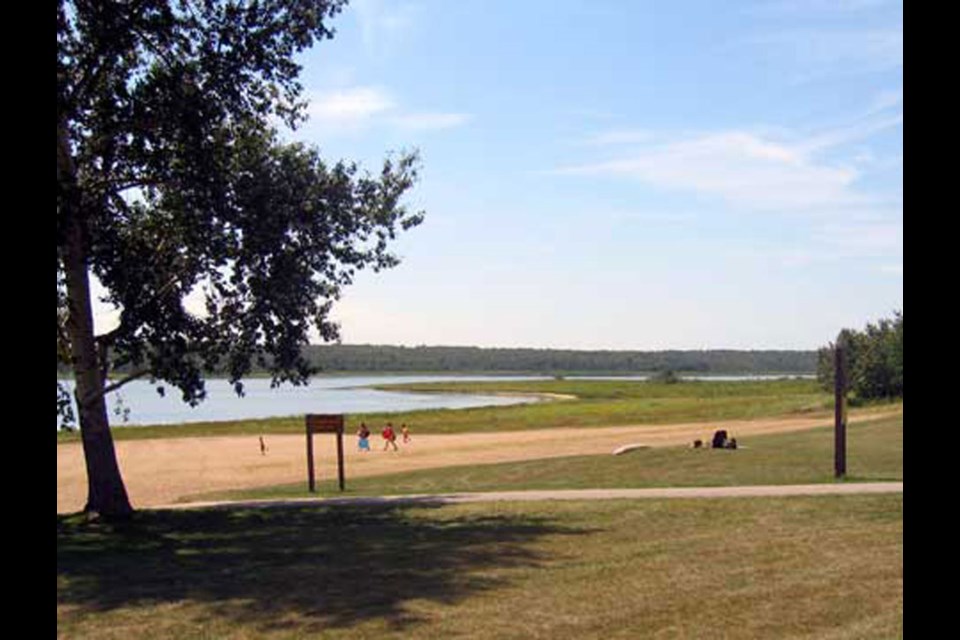KENOSEE LAKE — For many Saskatchewanians, their favourite summer pastime is spent at the lake. But what happens when the lake does not have enough water?
This is the problem the Moose Mountain Water Resource Management Corp (MMWRMC), a non-profit organization that tracks water levels, is trying to solve at Kenosee Lake, which is unique because it is on top of a hill.
“It’s not fed by any rivers, streams or creeks. All the water in Kenosee Lake comes from the back country,” said MMWRMC secretary Kim Crawford.
From measurements taken in the past, the last time Kenosee Lake was full was 1955. The levels started to change in the 1960s with oil development altering the landscape.
In 1977, Kenosee Lake received lots of precipitation.
“But they noticed the watershed was no longer draining into Kenosee Lake,” said Crawford.
Having a drought in the 1980s also lowered the lake’s levels. A 2009 measurement found that Kenosee Lake was at an all-time low.
“We were 20 feet below capacity,” said Crawford.
This was when the MMWRMC was formed.
“It was a group of local citizens who were concerned about the historically-low lake levels,” said Crawford.
In 2010, the superintendent in the park started mapping elevations, figuring out the existing watershed, and how to get water to flow to the lake. They also started doing low-level crossings, repairing culverts, removing beaver dams, and stiffening water in between lakes.
The lake was then restocked with fish and they lowered and expanded the culvert running between Little Kenosee and Kenosee Lake with new low-level crossings.
From 2010-2017, Kenosee Lake went up 17 feet, five inches.
“For comparison, during that same time, White Bear Lake rose six to eight feet so the difference between the two lakes is probably due to the efforts of our corporation and park staff working together,” said Crawford.
Kenosee Lake was two feet, seven inches from being full in 2017. In 2018, the government contracts and funding were taken away, and all the funding MMWRMC received through the Saskatchewan Association of Rural Municipalities was cancelled.
“The funding for the maintenance of Kenosee’s critical watershed was then supplied solely by our organization,” said Crawford.
As of the beginning of May 2025, Kenosee Lake was five feet, one inch from being full. They will continue to check back lakes and map elevations to determine runoff.
“The park staff assist where they can. Moose Mountain Provincial Park and our water management group have an excellent working relationship. We meet every year to determine a plan of action,” said Crawford.
They are currently concentrating on removing beaver dams, trenching and putting in low-level crossings.
“Without constant maintenance the back lakes would stop flowing again to Kenosee Lake and our park would lose a lot of its luster,” said Crawford. “Our job is to work with park staff to try and maintain the critical watershed and make sure the back lakes keep flowing to Kenosee Lake."
For Kenosee to be considered full, it must be at an altitude of 742.2 metres above sea level.
To get their measurements, MMWRMC compares everything to what they call full spill level
“This is what Kenosee, would be at full and how far down from there we are,” said Crawford.
As of May 2024 the water was down six inches.
“Kenosee is a shallow lake, so once the levels drop, we start losing all the fish, so the ecosystem then starts to fall apart. Kenosee relies on a lot of recreational activities. It’s a busy lake,” said Crawford.
At the time of publication Kenosee Lake was considered five feet from being full (five vertical feet along the shoreline).
“If you think of the lake being like a martini glass, if it drops down five feet along the shoreline, it’s coming in a lot more than five feet,” said Crawford. “It affects all the way around the shoreline. All of a sudden, we start to see areas of shore that are exposed that haven't been exposed for many years.”
Those at MMWRMC are trying to raise Kenosee Lake by the needed five feet. They plan on going out sometime in June and July to check and do maintenance.
Reporting from fall 2024 states there is very little water in the back lakes, but some of the lakes further back are getting full.
“We would look at trying to move some of that water forward so that if we do get a big dump of rain, we already have the water moved up as far as we can,” said Crawford. “Then with a little extra help from Mother Nature, we can get it flowing down into Kenosee again. We look where the water is backing up and they track it. Then if we can move it forward then that's what we are going to do.”
As a non-profit, MMWRMC acquire funds through memberships and donations.
"We don’t have any other source of income,” said Crawford.
Those interested in being part of the MMWRMC can purchase a yearly membership for $25.
For more information or a membership those interested can contact Crawford at [email protected].

.png;w=120;h=80;mode=crop)

